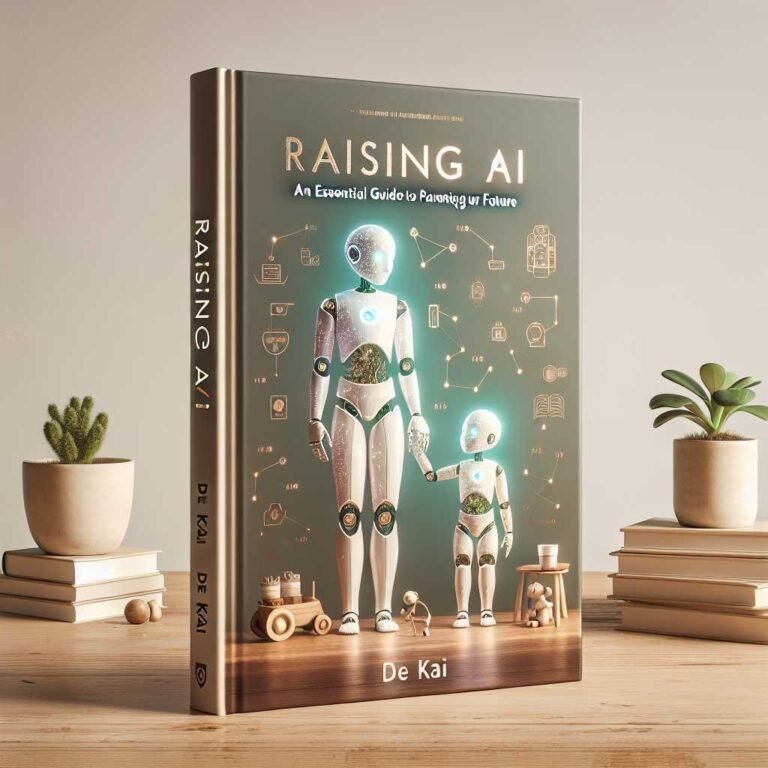Book Review: You Are Not Stupid — Computers and Technology, Simplified (2023 Update) by Jack C. Stanley, Erik D. Gross, and The Tech Academy
Do you ever feel like technology moved on without you? You’re not alone—and you’re definitely not “stupid.” If you’ve stared at a blinking router, felt nervous about cloud backups, or avoided “tech talk” at work, this book promises something rare: plain-English answers that actually stick. You Are Not Stupid: Computers and Technology Simplified (newly updated for 2023) sets out to make modern tech understandable to everyone—no jargon, no judgment, and no textbook boredom.
In this review, I’ll break down who this book is for, how it’s organized, what it does exceptionally well, and a few places it could go deeper. I’ll also share simple analogies and real-life tips you can use right away—whether or not you read the book cover to cover.
Let’s demystify the machines that run our lives. And yes, you can understand them.
What This Book Promises (and Delivers)
You Are Not Stupid is designed to be your friendly guide to tech literacy. It defines modern tech terms and explains how today’s devices work—in simple, everyday language. With more than 100 short chapters, it’s built for dipping in and out. No prior knowledge needed.
Here’s the heart of its promise: – Clear, non-judgmental explanations of computers, phones, networks, and the internet – Everyday examples and analogies instead of math-heavy diagrams – Practical knowledge you can use right away (think: password safety, backups, updates) – Coverage that keeps pace with today’s tech: cloud, AI, 5G, smart homes, and more
And the tone matters. The authors write as teachers, not gatekeepers. That empathy is the difference between a book you finish and a book that finishes you.
Who This Book Is For
You’ll get the most out of this book if you: – Feel behind on tech and want to catch up without embarrassment – Are a parent or grandparent helping kids with devices and internet safety – Work with computers daily but never got a “tech 101” foundation – Are returning to the workforce and need a confidence boost in digital skills – Prefer plain English over buzzwords and acronyms
It’s also a solid gift for a friend or family member who says, “I’m just not a computer person.” Spoiler: there’s no such thing.
How the Book Is Organized
Short chapters. Simple definitions. Everyday examples. That’s the formula. You can read it front to back or jump straight to what you need. Expect coverage like: – Hardware basics and how a computer actually works – Operating systems (Windows, macOS, Linux), apps, and updates – The internet and networking explained in real-world terms – Cloud storage, backups, and syncing without the confusion – Cybersecurity essentials for regular people – Smartphones, tablets, and the app ecosystem – Smart homes, streaming, and connected devices – Hot topics: AI, 5G, blockchain, and more
Think of it as a glossary with a brain—and a sense of humor.
Key Concepts Explained Simply (With Analogies That Stick)
Analogies turn abstract ideas into “aha!” moments. Here are a few the book’s style encourages—and how they help.
Hardware: The Computer as a Kitchen
- CPU = the chef who follows recipes (instructions)
- RAM = counter space for preparing dishes (temporary workspace)
- Storage (SSD/HDD) = your pantry and fridge (long-term ingredients)
- GPU = the sous-chef focused on visuals (graphics and video)
- Motherboard = the kitchen floorplan (everything connects here)
- Power supply = utilities that keep it all running
Why it matters: When your computer feels slow, you can ask smarter questions: Do I need more counter space (RAM) or a faster chef (CPU)? Is the pantry too small (storage)?
Software and Operating Systems: The House Manager
- The operating system is the home’s manager. It keeps everything in order, handles schedules, and lets people (apps) do their jobs without stepping on each other.
- Apps are specialized workers—word processors, browsers, design tools. You install what you need.
Why it matters: If an app crashes, the OS keeps the house standing. Updates to the OS and apps fix holes, speed things up, and add features.
The Internet & Networking: The Postal System
- Your device has an address (IP address) so data knows where to go.
- Routers act like local post offices, sending traffic to the right place.
- DNS is the address book that translates names (google.com) into numbers.
Why it matters: If the “mail” isn’t arriving, you can check your router, DNS, or connection—not just blame “the internet.” A basic mental map saves hours of frustration.
For a deeper dive into IP addresses and DNS, this primer is great: Cloudflare Learning Center: What is an IP address?
Cloud and Storage: The Library and the Backpack
- Local storage = your backpack (fast, close, limited)
- Cloud storage = a library that holds your books (accessible from anywhere, backed up)
- Syncing = keeping your notes identical across notebooks (devices)
Why it matters: You won’t fear “the cloud” when you see it as just somebody else’s computer—with rules. Want the formal definition? See NIST’s definition of cloud computing.
Security Basics: Lock the Front Door and Don’t Fall for Scams
- Passwords are keys. Use strong ones, and don’t reuse them.
- Two-factor authentication (2FA/MFA) is the deadbolt.
- Phishing is a con artist tricking you into handing over keys.
Why it matters: Most breaches start with a trick, not a hack. Good habits beat most threats. To build them: – Learn modern password rules from NIST – Turn on MFA with help from CISA’s guide – Spot phishing scams using the FTC’s checklist
Smartphones and Apps: Your Pocket Computer
- Your phone is a powerful computer with sensors (camera, GPS, accelerometer).
- Apps request permissions. Only grant what makes sense.
- Updates keep your phone safe and fast.
Why it matters: A few settings upgrades can transform your day-to-day—privacy, battery life, and safety improve with simple tweaks.
Smart Homes and IoT: Convenience With Caveats
- Smart thermostats, lights, speakers, and cameras are handy.
- Each new device is another front door. Change default passwords, update firmware, and segment your Wi‑Fi if possible (guest network for IoT).
Why it matters: Smart devices make life smoother but add risk. A simple setup plan reduces it.
Emerging Tech: AI, 5G, Blockchain (Without the Hype)
- AI and machine learning: pattern-finding systems that help with recommendations, images, and language. For a plain intro, see Stanford HAI’s AI 101.
- 5G: faster, lower-latency mobile networks that enable richer mobile experiences. Learn more via the FCC.
- Blockchain: a tamper-resistant ledger useful for certain types of records—not a cure-all.
Why it matters: Understanding what these terms mean (and don’t mean) helps you cut through marketing and make smart choices.
What’s New in the 2023 Update
Technology evolves fast. This updated edition shows its homework. Expect clarity on: – Cloud-first living: files, photos, and backups across devices – Passwordless logins and multi-factor authentication – Safer browsing and privacy controls – AI showing up in everyday tools (search, writing aids, image tools) – Remote and hybrid work essentials – Streaming, smart TVs, and home-network basics – Everyday security: scams, phishing, and social engineering
Here’s why that matters: updated tech literacy isn’t a “nice to have.” It’s the baseline for staying safe, productive, and confident in a digital world.
Why the Plain-Language Approach Works
Tech isn’t hard because it’s incomprehensible. It’s hard because: – Jargon piles up before the basics are grounded – People are afraid to ask “simple” questions – Explanations skip over context
This book avoids that trap. It: – Uses short chapters to reduce cognitive load – Builds from familiar analogies – Answers the “why” behind the “what” – Respects the reader’s intelligence
Let me explain: when you know why updates matter (they patch holes) and what those holes do (let attackers in), you stop ignoring update prompts. Knowledge changes behavior.
Strengths—and Where It Could Go Deeper
What the book nails: – Accessibility. It never talks down to the reader. – Breadth. It covers everyday tech from multiple angles. – Confidence-building. The tone invites questions and curiosity. – Timeliness. The 2023 update addresses what people face now.
Where it might leave advanced readers wanting: – Depth. By design, it’s broad rather than technical. You won’t get deep dives into programming, networking, or system internals. – Rapidly changing topics. Some sections (AI tools, platform-specific features) evolve so fast they may date quickly. – Hands-on exercises. If you learn best by doing, you may want companion checklists or worksheets. (No problem—see below for actionable steps you can take now.)
None of these are dealbreakers. They’re trade-offs that keep the book beginner-friendly.
How to Get the Most From This Book
Reading is great; applying is better. Here’s a simple plan.
1) Start with your biggest pain point
Scan the chapter list. Pick the topic that worries you—passwords, backups, or Wi‑Fi. You’ll get a fast confidence boost.
2) Build a two-week “tech hygiene” sprint
Each day, do one small task:
– Day 1: Update your phone and computer
– Day 2: Turn on 2FA for email and banking (CISA guide)
– Day 3: Install a password manager (Mozilla’s overview)
– Day 4: Create a simple 3-2-1 backup plan (3 copies, 2 media, 1 offsite). A clear explainer: Backblaze’s 3-2-1 strategy
– Day 5: Rename your Wi‑Fi network and change the router admin password
– Day 6: Review app permissions on your phone; revoke what you don’t need
– Day 7: Learn to spot phishing (FTC tips)
– Day 8–14: Repeat for other critical accounts and devices
3) Make it social
Teach a friend one thing you learned. Teaching cements knowledge—and helps someone else.
4) Keep a running tech notebook
Jot down settings, passwords hints (not the passwords), and backup locations. When something breaks, you’ll have a map.
How It Compares to Other Beginner-Friendly Tech Books
- Code by Charles Petzold: a beautiful, conceptual tour of how computers work at a fundamental level. It’s deeper on logic and history; less on practical daily tech.
- How Computers Work (Ron White): rich visuals and hardware focus. Great for understanding components; lighter on cloud, security, and modern workflows.
- For Dummies series (e.g., Computers for Seniors): task-focused guides (how to email, browse, store photos). Useful, but not as broad on modern concepts or security mindsets.
You Are Not Stupid sits in a sweet spot: plain-English tech literacy across hardware, software, the internet, and safety—without assuming you’ll become a technician.
Memorable Ideas You’ll Carry With You
- “Updates patch holes.” That’s why you don’t skip them.
- “Cloud = library, local = backpack.” You’ll know which to use and why.
- “MFA is a deadbolt.” You’ll add it to your most important accounts.
- “Every device is a door.” You’ll change defaults and keep firmware current.
These mental models stick. And once they do, you won’t feel lost when tech chatter starts.
Is It Current Enough?
Yes—for what it aims to do. The 2023 refresh reflects how we actually use technology now: phones as primary devices, cloud storage for photos, streaming everything, hybrid work, AI in productivity tools, and constant scams. For ongoing best practices, bookmark: – CISA: Home Network Security – EFF: Surveillance Self‑Defense
Books can’t update weekly, but paired with a couple trusted sources, you’ll stay ahead of the curve.
Where to Buy and Learn More
- Find the book on major retailers such as Amazon and check reader reactions on Goodreads.
- Learn about the authors’ tech education work via The Tech Academy’s website: learncodinganywhere.com (educational resource).
Note: Availability and editions may vary by region.
Final Verdict: Should You Buy It?
If you’ve ever thought, “I’m just not a tech person,” this book is a kind, clear antidote. It’s practical without being preachy, broad without being blurry, and current without drowning you in buzzwords. Will it turn you into a network engineer? No—and that’s the point. It will make you confident with the tools you use every day and safer online.
Buy it for yourself to build a foundation. Or give it to someone who needs a judgment-free on-ramp to modern tech. You’ll both be better for it.
Useful Resources to Pair With the Book
- NIST: Digital Identity & Password Guidance
- CISA: Multi-Factor Authentication
- FTC: How to Recognize and Avoid Phishing Scams
- Stanford HAI: AI 101
- FCC: What Is 5G?
- Cloudflare: What is an IP address?
- Mozilla: Why Use a Password Manager
- Backblaze: The 3-2-1 Backup Strategy
- EFF: Surveillance Self‑Defense
FAQ: You Are Not Stupid — Computers and Technology, Simplified
Q: Do I need any background in tech to read this book?
A: No. It’s written for complete beginners and curious readers. You’ll get plain-English explanations and everyday examples.
Q: Is this a good book for seniors or non-technical adults?
A: Absolutely. The tone is respectful and the chapters are short. Many readers buy it for parents or grandparents who want confidence with phones, computers, the cloud, and online safety.
Q: Does the 2023 update cover AI and modern security?
A: Yes. It addresses AI’s growing role in daily tools, multi-factor authentication, safer browsing, cloud-first workflows, and common scams.
Q: Will I learn to code from this book?
A: You’ll learn what code is and how computers follow instructions, but it’s not a programming course. Think tech literacy, not technical training.
Q: Is this better in print or eBook?
A: It comes down to preference. Print is easier for flipping between short chapters and taking notes; digital is searchable and portable.
Q: How is this different from the “For Dummies” series?
A: The Dummies books are often task-based for specific platforms or audiences. You Are Not Stupid focuses on universal tech literacy—concepts, safety, and confidence—across devices and platforms.
Q: What’s one thing I can do today to be safer online?
A: Turn on multi-factor authentication for your email and bank accounts. It’s the single biggest boost to account security. Start here: CISA on MFA.
Q: Where can I buy it?
A: Major online retailers like Amazon carry it, and you can browse community reviews on Goodreads.
The Takeaway
You are not behind. You’re not “bad at tech.” You just haven’t had it explained to you in a way that respects your time and your intelligence. This book does that—cleanly, kindly, and with zero jargon.
If you want to feel calm, competent, and secure with your devices, start here. And if you found this review helpful, stick around—I share practical, plain-English tech guides regularly. Subscribe for more tips you can use right away.
Discover more at InnoVirtuoso.com
I would love some feedback on my writing so if you have any, please don’t hesitate to leave a comment around here or in any platforms that is convenient for you.
For more on tech and other topics, explore InnoVirtuoso.com anytime. Subscribe to my newsletter and join our growing community—we’ll create something magical together. I promise, it’ll never be boring!
Stay updated with the latest news—subscribe to our newsletter today!
Thank you all—wishing you an amazing day ahead!
Read more Literature Reviews at InnoVirtuoso
- Shadowbanned: The War on Truth and How to Escape It — Book Review, Insights, and the Digital Free Speech Survival Guide
- The Art and Science of Vibe Coding: How Kevin L Hauser’s Book Unlocks the Future of No-Code AI Software Creation
- Quantum Computing: Principles, Programming, and Possibilities – Why Anshuman Mishra’s Comprehensive Guide Is a Must-Read for Students and Researchers
- Book Review: How “Like” Became the Button That Changed the World – Insights from Martin Reeves & Bob Goodson
- Book Review: Age of Invisible Machines (2nd Edition) — How Robb Wilson & Josh Tyson’s Prophetic AI Playbook Prepares Leaders for 2027 and Beyond
- Almost Timeless: The 48 Foundation Principles of Generative AI – Why Mastering Principles Beats Chasing Hacks
- The AI Evolution: Why Every Business Leader Needs Jason Michael Perry’s Roadmap for the Future







